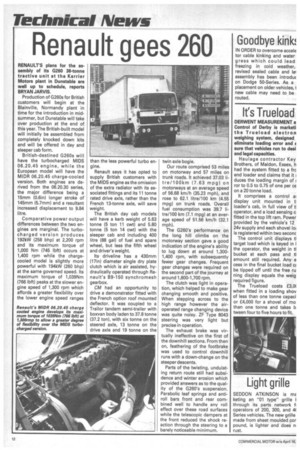Technical News
Page 14

If you've noticed an error in this article please click here to report it so we can fix it.
Renault gees 260
RENAULT'S plans for the assembly of its G260 38-tonne tractive unit at the Karrier Motors plant in Dunstable are well up to schedule, reports BRYAN JAR VIS.
Production of G260s for British customers will begin at the Blainville, Normandy plant in time for the introduction in midsummer, but Dunstable will take over production at the end of this year. The British-built model will initially be assembled from completely knocked down kits and will be offered in day and sleeper cab form.
British-destined G260s will have the turbocharged MIDS 06.20.45 engine, while the European model will have the MIDR 06.20.45 charge-cooled version. Both engines are derived from the 06.20.30 series, the major difference being a 15mm (0.6in) longer stroke of 145mm (5.7mm) and a resultant increased displacement to 9.84 litre.
Comparative power output differences between the two engines are marginal. The turbocharged version produces 192kW (258 bhp) at 2,200 rpm and its maximum torque of 1,000 Nm (745 lbft) occurs at 1,400 rpm while the chargecooled model is slightly more powerful with 194kW (260 bhp) at the same governed speed. Its maximum torque of 1,039Nm (766 lbft) peaks at the slower engine speed of 1,300 rpm which affords a greater flexibility over the lower engine speed ranges than the less powerful turbo engine.
Renault says it has opted to supply British customers with the MIDS engine as the omission of the extra radiator with its associated fittings and its 11 tonne rated drive axle, rather than the French 13-tonne axle, will save weight.
The British day cab models will have a kerb weight of 5.63 tonne (5 ton 11 cwt) and 5.80 tonne (5 ton 14 cwt) with the sleeper cab and including 400 litre (88 gal) of fuel and spare wheel, but less the fifth wheel and driver's weight.
Its driveline has a 430mm (17in) diameter single dry plate clutch which is air assisted, hydraulically operated through Renault's B9-150 synchromesh gearbox.
CM had an opportunity to drive a demonstrator fitted with the French option roof mounted deflector. It was coupled to a Trailor tandem semi-trailer with boxvan body laden to 37.8 tonne (37.2 ton), with six tonne on the steered axle, 13 tonne on the drive axle and 19 tonne on the twin axle bogie.
Our route comprised 53 miles on motorway and 57 miles on trunk roads. It achieved 37.03 litre/100km (7.63 mpg) on motorways at an average speed of 56.68 km/h (35.23 mph), and rose to 62.1 litre/100 km (4.55 mpg) on trunk roads. Overall fuel consumption was 39.7 litre/100 km (7.1 mpg) at an average speed of 51.56 km/h (32.1 mph).
The G260's performance on the long hill climbs on the motorway section gave a good indication of the engine's ability to lug down at around 1,3001,400 rpm, with subsequently fewer gear changes. Frequent gear changes were required on the second part of the journey at around 1,600-1,700 rpm.
The clutch was light in operation, which helped to make gear changing smooth and positive. When stepping across to the high range however the airoperated range changing device was quite noisy. ZF Type 8043 steering was very light but precise in operation.
The exhaust brake was virtually ineffective on the first of the downhill sections. From then on, feathering of the footbrake was used to control downhill runs with a down-change on the steeper descents.
Parts of the twisting, undulating return route still had subsidence and winter erosion which provided answers as to the quality of the G260's suspension. Parabolic leaf springs and antiroll bars front and rear combined well to handle any roll effect over these road surfaces while the telescopic dampers at the front reduced the shock reaction through the steering to a barely noticeable minimum.




















































































